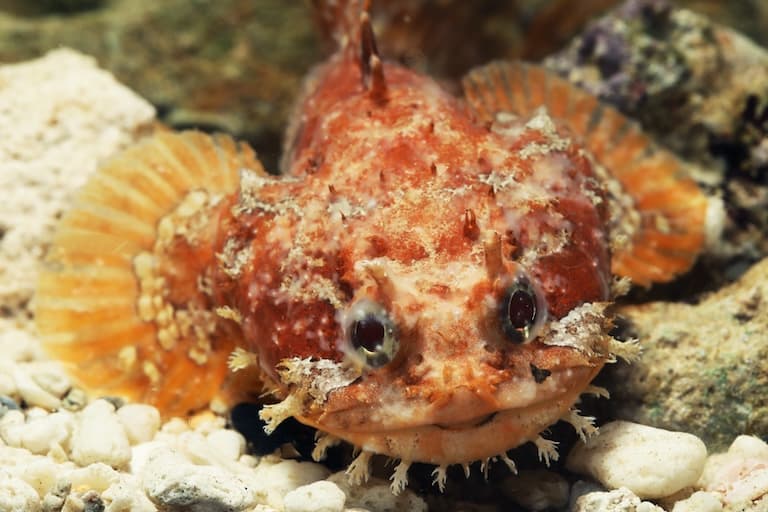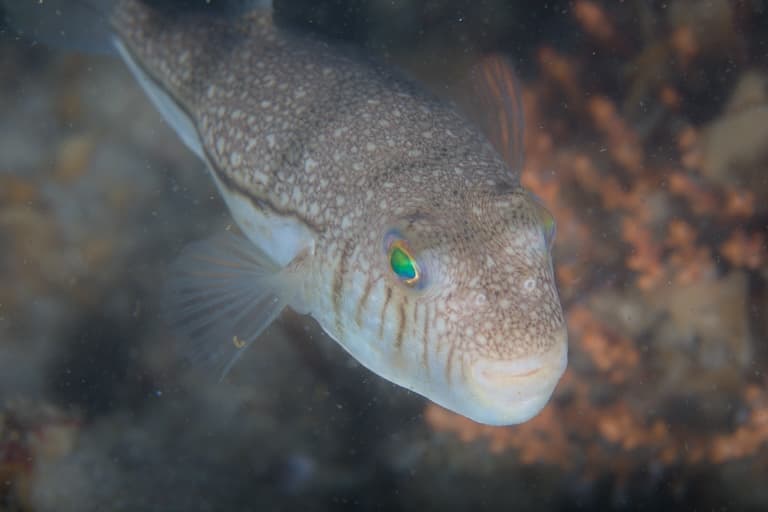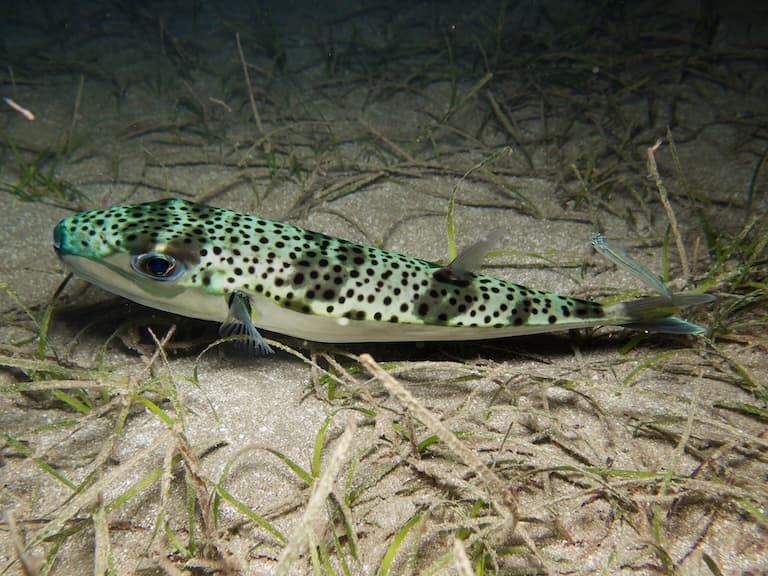Toadfish Profile
Two of the scariest words in zoology are Batrachotoxin and Tetrodotoxin. These are the poisons found in the infamous poison dart frogs and the blue-ringed octopus, respectively. But these frightening chemicals are quite prevalent in the natural world (the frog actually gets it from a beetle) and particularly common in the ocean.
The common name, “Toadfish”, refers to many types of unrelated fish, but the two main groups are members of the families Batrachoididae and Tetraodontidae, and this is not a coincidence. The latter is a pufferfish family, which we’ve talked about before and is notoriously toxic. But the former, the Batrachoids, are a lesser-known family of quite different fish, and the group of Toadfishes we will be focused on here.
But are they as dangerous as their name would suggest?

Toadfish Facts Overview
| Habitat: | Benthic marine, sediment layer; some brackish, some freshwater |
| Location: | Worldwide |
| Lifespan: | 13 years or more |
| Size: | The largest are 57 cm (22 in) long, the smallest are around 7.5 cm (3.0 in) |
| Weight: | Up to 2.3 kg (5.1 lb) |
| Colour: | Usually plain, drab, camouflaged with the sediment. Some bright and patterned |
| Diet: | Invertebrates |
| Predators: | Larger predators, like tuna, cetaceans |
| Top Speed: | Slow |
| No. of Species: | 9 + |
| Conservation Status: | Least Concern |
Toadfishes are some of the oldest ray-finned fishes known, which is a pretty special title, considering how diverse that clade is. And they’re diverse within their family, too.
Most are dull-looking, but some are splendid, and they can talk, sting and mislead with both their common and scientific names!
Interesting Toadfish Facts
1. They’re ancient
The clade of bony fishes called Percomorpha represents a relatively recent radiation of ray-finned fishes beginning sometime in the Late Cretaceous. This might not sound recent, being, as it was, 70-90 million years ago, but it’s worth remembering that ray-finned fishes owe their roots to a Devonian explosion, some 400 million years ago.
And a lot has happened since then, but today, Percomorpha is represented by around 60% of all ray-finned fishes, from freshwater perch to seahorses. And contains more species than any other clade of vertebrates.
So, as you’d expect from a clade of almost 20,000 species, there’s a lot of diversity here. But the earliest members determined from the fossil record, stemming from that Late Cretaceous ancestry, are the toadfishes. Ugly bottom-feeders that nobody wants to hang out with.
And from this single family of prehistoric slobs came the plethora of marine fishes that today make up the Percomorph clade.
And this family, too, exhibits pretty remarkable diversity.

2. They’re diverse
Not only are toadfish found in marine waters worldwide, but they’re also found in brackish and freshwater systems, too. They range in size from the roughly 60 cm Pacuma toadfish to the relatively petite 7 cm big-eyed toadfish, and vary in shape and colour by – well, not so much, actually.
Toadfishes are, for the most part, ambush predators that hide in the mud, so they have to look a bit like mud to accomplish this. They also have upturned mouths and eyes that bulge from the tops of their heads for the same reason, and so this generally isn’t the prettiest of families of fish.
But there are exceptions!
3. They can be beautiful
The so-called “Splendid” toadfish carries with it that old Victorian naturalist’s euphemism for “Really cool-looking”.
And it is really cool-looking! Not even just for a toadfish, either.
Unlike its mud-coloured, drab compatriots, this fish has gone for a bold purple base colour with vibrant, zig-zaggy stripes and striking yellow-rimmed fins. Its barbelled mouth and beady white eyes poke out from cervices in coral reefs, and if you listen carefully, it will speak to you.

4. They talk
This species is one of many toadfish species that make sounds on purpose for the purpose of communication. When we do this, we generally call it talking, and when animals do it, we generally call it “vocalising” so as not to confront how basic we are.
But in our defence, we do try to put words and sentences together, and with some exceptions, most animals don’t appear to be doing that. The toadfishes make buzzing, popping or horn-like sounds, apparently using their swim bladders, to call for mates, or perhaps to tell divers to piss off.
5. They glow
Toadfishes are also known for having photophores, or light-emitting cells in their skin.
Midshipman fish are a genus of toadfish that is well known for this trait. These bioluminescent fish are nocturnal but still opt to bury themselves in the sand and mud most of the time, so the role of these photophores seems uncertain.
Another cool thing about these fish is that they come in a variety of sizes. And not in the standard, sexual dimorphism kind of way, where the males and females differ, but males themselves come in two morphs. One is eight times the size of the other, and they both have their own mating strategies.
The larger males are very similar to the females, and can mostly be told apart by their very large reproductive organs. This is, incidentally, also how animal bloggers can be told apart from, say, cryptocurrency bloggers1.
Yet another thing these fish are known for, though, is what happens to people who pick them up.
6. They sting
Batrachotoxin, found in poison dart frogs, and some beetles and birds, doesn’t give you any such loophole and is one of the most dangerous chemical substances known to man.
Batrachotoxin leaves sodium channels in nerve tissue open, and causes what doctors refer to as “a right mess”, which quickly manifests as total spasms and paralysis in the mammalian system. But worse, unlike the “other” toadfishes in the pufferfish family, this one affects the heart2.
But this is a digression, and we have a confession to make. Because the above was all just an excuse to talk about the most killer alkaloid in nature. The truth is, the toxins in toadfishes don’t appear to be related to this at all.
Toadfishes are often covered in spines, and these spines often inject medically significant toxins into anything pestering them, but their venom has yet to be fully assessed. The fact that it hurts tremendously suggests it’s not – or at least not only – Batrachotoxin, which doesn’t really hurt at all3.
Instead, a toxin called Nattectin has been identified in one genus, which is so obscure it doesn’t yet have a Wikipedia entry for it. Fishermen report a lot of pain and inflammation when stung by these fish, but so far, the data is lacking on the severity and specific content of toadfish venom.
So, why the name? Well, Batrachotoxin is named after the frog that secretes it, and so the Batrachoididae family shares the root for the Greek word for frog: batrakhos.
7. Some are struggling
This ancient family of fish survived the dinosaur extinction to become basal to the majority of ray-finned fishes alive today, but human activities are no mere 15km-wide asteroid! Our unrelenting pillaging of the oceans has left at least some toadfish species in trouble.
One such species is the aforementioned beauty: the Splendid toadfish. Reef health in general is lacking around the world, and this is but one casualty of that, but dredging, anchor-dropping, and various other ignorant behaviours are compounding its decline4. This species is now endangered.
Another troubled species is the reticulated toadfish, currently listed as vulnerable as a result of the habitat destruction of coastal development5.
Toadfish Fact-File Summary
Scientific Classification
| Kingdom: | Animalia |
| Phylum: | Chordata |
| Class: | Actinopterygii |
| Order: | Batrachoidiformes |
| Family: | Batrachoididae |
| Genus: | 21 genera |
| Species Name: | 80+ species |
Fact Sources & References
- Brantley & Bass (1994), “Alternative Male Spawning Tactics and Acoustic Signals in the Plainfin Midshipman Fish Porichthys notatus Girard (Teleostei, Batrachoididae)”, Wiley Online Library.
- Ferreira et, al (2014), “Clinical manifestations and experimental studies on the spine of the toadfish Porichthys porosissimus”, Toxicon.
- Collette ,“Order BATRACHOIDIFORMES BATRACHOIDIDAE”, Fao.org.
- Aiken & Fernandez(2015), “Splendid Toadfish”, The IUCN Red List of Threatened Species.
- Acero & Betancur (2010), “Reticulated Toadfish”, The IUCN Red List of Threatened Species.
